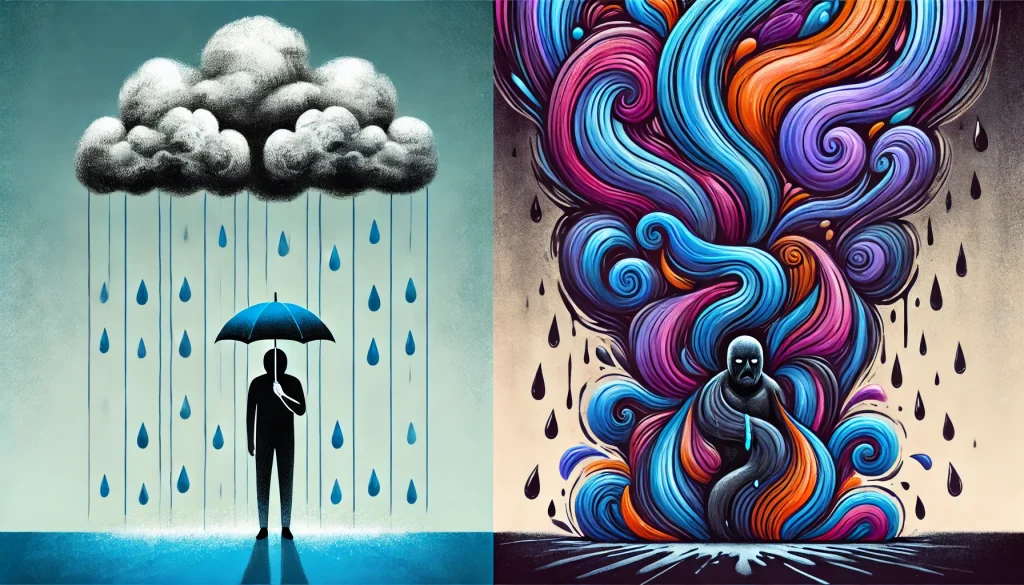
We all feel sad sometimes. It’s a normal reaction to life’s changes, like losing a job, going through a breakup, or watching a sad movie. But sadness and depression are not the same thing, even though they can feel similar at times. Understanding the difference is important for recognising when someone might need more than just a shoulder to cry on.
Sadness is a healthy, human emotion. It’s a part of life that helps us process loss, disappointment, or change. Think of it as a passing cloud—sometimes it’s heavy and dark, but it eventually moves on. When we’re sad, we might cry, feel down, or lose interest in activities for a while. However, we can usually still find moments of joy or laughter, and the sadness typically fades as circumstances change or as we come to terms with what caused it.
Depression, on the other hand, is more than just feeling sad. It’s like being trapped in a storm that doesn’t pass, no matter how much we wish it would. It’s a persistent feeling of emptiness, hopelessness, or numbness that can last for weeks, months, or even years. Depression isn’t just about feeling down; it can affect every aspect of our lives, from our thoughts and emotions to our physical health and behaviour.
One key difference between sadness and depression is duration and intensity. Sadness tends to be short-lived and tied to specific events. For example, if we lose a pet, we might feel sad for days or even weeks, but as we grieve and heal, those feelings start to lift. Depression, however, isn’t always linked to a particular event and doesn’t go away easily. It can feel like carrying a weight that grows heavier over time, making it hard to see a way out.
Another distinction is how these feelings affect our daily functioning. When we’re sad, we might still be able to go to work, take care of responsibilities, and enjoy time with friends, even if we feel down. Depression, however, can make even the simplest tasks feel impossible. Getting out of bed, eating, or even talking to others can seem like monumental challenges. It’s like a fog that clouds our mind and drains our energy, making it hard to engage with the world around us.
Let’s take the example of Taylor. Taylor recently experienced a breakup and felt incredibly sad. For a few weeks, Taylor cried often, felt uninterested in hobbies, and didn’t want to see friends. However, with time, Taylor began to feel better, started enjoying activities again, and even laughed with friends about old times.
Now, consider someone named Jamie. Jamie has been feeling down for several months, but there wasn’t a specific event that triggered it. Jamie feels tired all the time, has trouble sleeping, and can’t remember the last time they genuinely enjoyed something. Jamie often feels worthless and thinks, “What’s the point?” This has affected Jamie’s work, relationships, and overall ability to function. Unlike Taylor’s sadness, Jamie’s experience is more persistent and pervasive, indicating something more serious, like depression.
It’s also important to note that depression can include physical symptoms that go beyond what we experience with sadness. People with depression might have unexplained aches and pains, digestive issues, or changes in appetite and weight. These physical symptoms can make it even harder to recognise and address the problem, as they can easily be mistaken for other health issues.
Understanding the difference between sadness and depression helps us respond appropriately to what we or others might be going through. While it’s normal to feel sad at times, ongoing or intense feelings of sadness, hopelessness, or numbness could be signs of depression. This distinction is crucial because it informs how we seek help and support. Sadness might pass with time, a supportive conversation, or a comforting movie, but depression often requires more structured support, like therapy or medical intervention.
In recognising the difference between sadness and depression, we also learn the importance of empathy and support. It can be easy to say, “Cheer up,” or “It’ll get better,” to someone who’s sad. But when it comes to depression, those words, though well-intentioned, can feel dismissive. Understanding that depression is not just an extension of sadness helps us offer the right kind of support—listening without judgment, encouraging professional help, and being patient with the person experiencing it. In our journey to understand these emotions, it’s clear that sadness and depression, though related, are distinct experiences. By recognizing and respecting this difference, we can better support ourselves and others, making it easier to handle challenges.
If you or someone you love is struggling with depression, you don’t have to go through it alone. At My Practice Counselling Melbourne, Jonathan Riley and our team are here to help. Reach out today to start your journey toward a healthier, happier life. Contact us now to book an appointment.